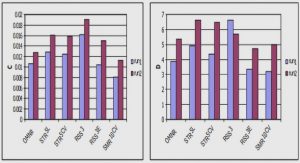Get Complete Project Material File(s) Now! »
Effectiveness
Effectiveness could be defined as the extent to which an organisation is successful in producing the desired results or objectives (Concise Oxford Dictionary 1995:432). In public administration, the concept effectiveness or organisational effectiveness denotes an ideal situation where an organisation uses a finite number of resources and is able to achieve the stated objectives as measured by a given set of criteria (Fox & Meyer 1995:41). Thus, the effectiveness of an organisation is determined by the ability to formulate policies and deliver goods and services for which the organisation was created.
Decision-making
According to Shafritz (2004:85), decision-making can be defined as a complex process of selecting the most desirable course of action from among the various alternatives. Thus it involves a conscious activity that analyses information in a bid to provide solutions in order to address a specific phenomenon by discernment.
Service delivery
Service delivery refers to the collective goods and services which the government provides, or is expected to provide, to its inhabitants as regulated by public policies and legislation. Hemson, Carter and Karuri- Sebina (2009:156) define service delivery as the end product of a series of policies and actions involving government plans and budget. For the purpose of this research, the term service delivery will be used to denote the goods and services that the government is expected to provide in ensuring that the sustainable livelihoods of its citizens are maintained.
The art or science of Public Administration: a debate on the nature of the discipline
The discipline of Public Administration is a complex field of study. It possesses critical elements of scientific and artistic studies. Science is generally known as a branch of study that deals with a body of facts or truths. Fukuyama (2004:189) accentuates public administration as more of an art than a scientific field of study, on the basis that the discipline does not have globally valid rules. Berkley and Rouse (2004:7) profess that public administration shares traits with both the arts and the sciences. This makes it a unique field that could be classified as a craft, as opposed to either a science or an art.
Hodgkinson (1978:4) argues that over time the discipline of Public Administration has been diluted by some elements that signify the management practice. Thus it becomes difficult to classify the discipline of Public Administration as either a science or an art, without having to commence making a distinction between the concepts of administration and management. With the necessary distinction of the two concepts in place, it then becomes easier to establish that Public Management favours the art of applying managerial techniques and Public Administration favours the sciences component. A system of public administration is a combination of all the laws, regulations, practices, relationships, codes and customs that prevail at any time in any jurisdiction in order to fulfil a public policy (White 1955:2). Hence, the process of administration could be considered a dynamic art which acknowledges all the resources present in the quest to achieve a particular goal. Thus, public administration makes provision for the directing, co-ordinating and monitoring the actions of people towards achieving a specific objective. Nonetheless, Kuye (2005:526) notes that the discipline is a combination of both science and art, and should not be dismissed purely as unscientific art. It can thus be deduced that Public Administration is a field of study with unique characteristics, aimed at solving problems with which the government is confronted. With both the elements of science and art, inherent within the discipline, Public Administration could be applicable to both scientific and artistic analysis.
1. CHAPTER 1: GENERAL INTRODUCTION AND METHODOLOGICAL FRAMEWORK OF THE RESEARCH
1.1. INTRODUCTION AND BACKGROUND
1.2. PURPOSE AND SIGNIFICANCE OF THE STUDY
1.3. MOTIVATION FOR THE RESEARCH
1.4. SURVEY OF THE LITERATURE
1.5. PROBLEM STATEMENT AND RESEARCH QUESTIONS
1.6. AIMS AND OBJECTIVES OF THE RESEARCH
1.7. RESEARCH DESIGN
1.8. RESEARCH METHODS
1.9. LIMITATIONS OF THE STUDY
1.10. CLARIFICATION OF TERMS AND CONCEPTS
1.11. PRELIMINARY FRAMEWORK OF THE RESEARCH
1.12. CONCLUSION
2. CHAPTER 2: THEORETICAL CONSTRUCTS IN PUBLIC ADMINISTRATION
2.1. INTRODUCTION
2.2. CONCEPTUAL ANALYSIS AND THE ORIGIN OF PUBLIC ADMINISTRATION
2.3. GENERIC FUNCTIONS OF PUBLIC ADMINISTRATION
2.4. SCOPE OF LOCAL GOVERNMENT IN PUBLIC ADMINISTRATION
2.5. ROLE OF THE STATE
2.6. HISTORICAL DEVELOPMENT OF LOCAL GOVERNMENT IN SOUTH AFRICA
2.7. REQUIREMENTS FOR AN EFFECTIVE AND EFFICIENT ADMINISTRATION AND MANAGEMENT OF LOCAL GOVERNMENT
2.8. THE POLITICAL FUNCTION RELATING TO PUBLIC ADMINISTRATION
2.9. CONCLUSION
3. CHAPTER 3: ROLE AND FUNCTIONS OF MUNICIPALITIES AND INTERNATIONAL EXPERIENCE OF LOCAL GOVERNMENT AUTHORITIES
3.1. INTRODUCTION
3.2. DECISION-MAKING, PLANNING AND LEGISLATIVE OVERSIGHT
3.3. INTERNATIONAL EXPERIENCES: TRENDS AND DEVELOPMENTS IN SELECTED COUNTRIES
3.4. CASE STUDY: EXPERIENCE OF LOCAL GOVERNMENT IN THE UNITED KINGDOM
3.5. CONCLUSION
4. CHAPTER 4: SYSTEM OF LOCAL GOVERNMENT IN SOUTH AFRICA
4.1. INTRODUCTION
4.2. GOVERNMENT SYSTEM IN SOUTH AFRICA
4.3. BACKGROUND OF SOUTH AFRICAN LOCAL GOVERNMENT
4.4. POLICIES AND LEGISLATIVE IMPERATIVES CONCERNING LOCAL GOVERNMENT
4.5. STRUCTURE AND SYSTEM
4.6. STRATEGIES IMPLEMENTED TO ENHANCE SERVICE DELIVERY
4.7. CONCLUSION
5. CHAPTER 5: ANALYSIS AND INTERPRETATION: FACTORS INFLUENCING DECISION-MAKING IN MUNICIPAL COUNCILS
5.1. INTRODUCTION
5.2. BACKGROUND OF GAUTENG PROVINCE
5.3. METROPOLITAN MUNICIPALITIES
5.4. GOVERNMENT AND ADMINISTRATION OF SELECTED METROPOLITAN MUNICIPALITIES
5.5. FACTORS INFLUENCING DECISIONS OF METROPOLITAN MUNICIPAL COUNCILS IN GAUTENG
5.6. CONCLUSION
6. CHAPTER 6: FINDINGS, RECOMMENDATIONS AND GENERAL CONCLUSION
6.1. INTRODUCTION
6.2. SUMMARY OF PREVIOUS CHAPTERS
6.3. FINDINGS AND RECOMMENDATIONS
6.4. LOGICAL FRAMEWORK FOR ENHANCING DECISION MAKING IN MUNICIPAL COUNCILS
6.5. FURTHER RESEARCH
6.6. SUMMARY
7. BIBLIOGRAPHY





